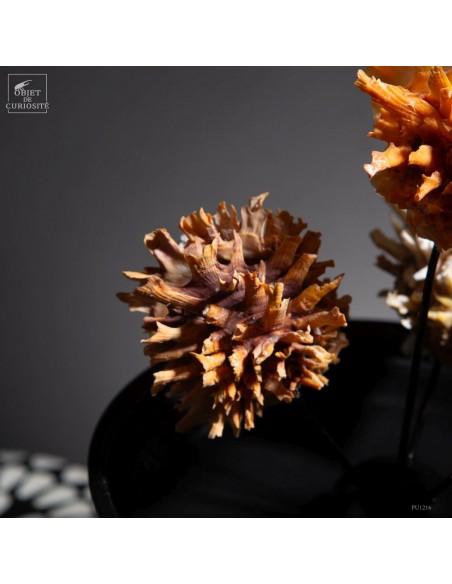4 Chama Shells Under a Bubble Glass Dome
PU1216
Chama, also known as “jewel shells,” are marine bivalve mollusks belonging to the Chamidae family.
Their range extends along the coasts of West Africa, from the southern Iberian Peninsula to Senegal, including the Mediterranean basin and reaching as far as the Cape Verde Islands, the Canary Islands, and the Azores. Some species, such as Chama pacifica, originate from the Indo-Pacific and have colonized the eastern Mediterranean via the Suez Canal.
These shells are characterized by their thick, asymmetrical, and stratified structure, providing effective protection against predators and ocean currents. Their upper surface, often encrusted with algae and sponges, becomes a miniature ecosystem in itself.
Unlike oysters, Chama attach firmly to rocks by secreting their own calcareous cement. Their irregular, rugged shells often lead to confusion with coral formations.
Our unique presentation, under a bubble glass dome, highlights these four Chama shells arranged like a marine bridal bouquet.
Their range extends along the coasts of West Africa, from the southern Iberian Peninsula to Senegal, including the Mediterranean basin and reaching as far as the Cape Verde Islands, the Canary Islands, and the Azores. Some species, such as Chama pacifica, originate from the Indo-Pacific and have colonized the eastern Mediterranean via the Suez Canal.
These shells are characterized by their thick, asymmetrical, and stratified structure, providing effective protection against predators and ocean currents. Their upper surface, often encrusted with algae and sponges, becomes a miniature ecosystem in itself.
Unlike oysters, Chama attach firmly to rocks by secreting their own calcareous cement. Their irregular, rugged shells often lead to confusion with coral formations.
Our unique presentation, under a bubble glass dome, highlights these four Chama shells arranged like a marine bridal bouquet.












